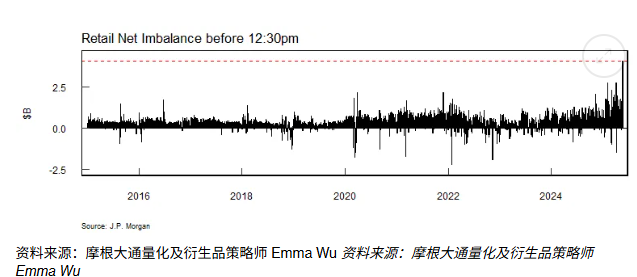Individual traders on Monday launched a record low-buying frenzy, reversing the 1% decline of the S&P 500 index triggered by Moody’s downgrade of the US credit rating over the weekend.
According to data compiled by JPMorgan Chase’s quantitative and derivatives strategist Emma Wu, as of 12:30 p.m. New York time, individual investors net bought $4.1 billion of U.S. stocks, hitting the highest level for the period and breaking through the $4 billion mark for the first time at midday.

The S&P 500 index dropped by nearly 1.1% at the opening on Monday, but by the afternoon, it had rebounded. As of 2:50 p.m. New York time, trading volume was roughly flat. Retail trading accounted for 36%, surpassing the historical high of late April.
On Monday, most Wall Street strategists shrugged off Moody’s downgrade and advised clients to keep buying stocks. Michael Wilson, a strategist at Morgan Stanley, said investors should take advantage of the U.S. stock market’s decline on Friday following the downgrade to buy, as the truce in the U.S.-China trade war has reduced the likelihood of a recession. Max Kerthner, chief multi-asset strategist at HSBC Holdings Plc, said his team views any decline in risky assets as an opportunity to increase exposure.
According to JPMorgan Chase, retail investors bought $2.5 billion worth of individual stocks on Monday, while exchange-traded funds (ETFs) purchased $1.5 billion worth of stocks. Retail investors made large purchases of popular stocks such as Tesla Inc. and Palantir Technologies Inc., with inflows of $675 million and $439 million respectively. They also invested in Bitcoin ETFs, while remaining net sellers of Nvidia Corp.
Jamie Dimon, the CEO of JPMorgan Chase, has warned that a series of risks should not be taken lightly. He listed various risks ranging from inflation, credit spreads to geopolitics.
Damon said that the possibility of rising inflation and stagflation is greater than people think, and warned that asset prices in the United States remain high, and that credit spreads have not taken into account the impact of a potential economic recession.
“Credit risk is very high today,” he said at the investor day on Monday. “Those who haven’t experienced a major economic recession don’t realize what could happen in the credit market.”
The Trump administration’s rapidly changing tariff policies led to a sharp market decline amid concerns over a recession and the safety of US assets. However, as the president boasted of progress in tariff negotiations, the market rebounded. Even after Moody’s downgraded the US’s last top credit rating on Friday, the S&P 500 index still recovered its initial losses on Monday, as traders seemed not to focus on the impact of the downgrade.
“People feel good because they haven’t seen the impact of tariffs yet,” Dimon said. “The stock market has dropped 10% and then rebounded 10%; I think this is an extremely complacent mood.”
The United States is still engaged in tariff negotiations with multiple economies, including Japan, South Korea, India and the European Union. Trump recently agreed to reach a trade framework agreement with the United Kingdom and a temporary tariff reduction agreement with China, buying more time for the negotiations.
Daimon said that even though the tax rates are relatively low, they are still “quite high”. He also added that it is not clear how countries will respond, and the recovery of the US manufacturing industry will also take time. Daimon also pointed out that corporate profit expectations may decline.
“I think we can’t predict the outcome. I think the possibility of inflation rising and stagflation is higher than others think,” he said, and reiterated that geopolitical risks remain high.